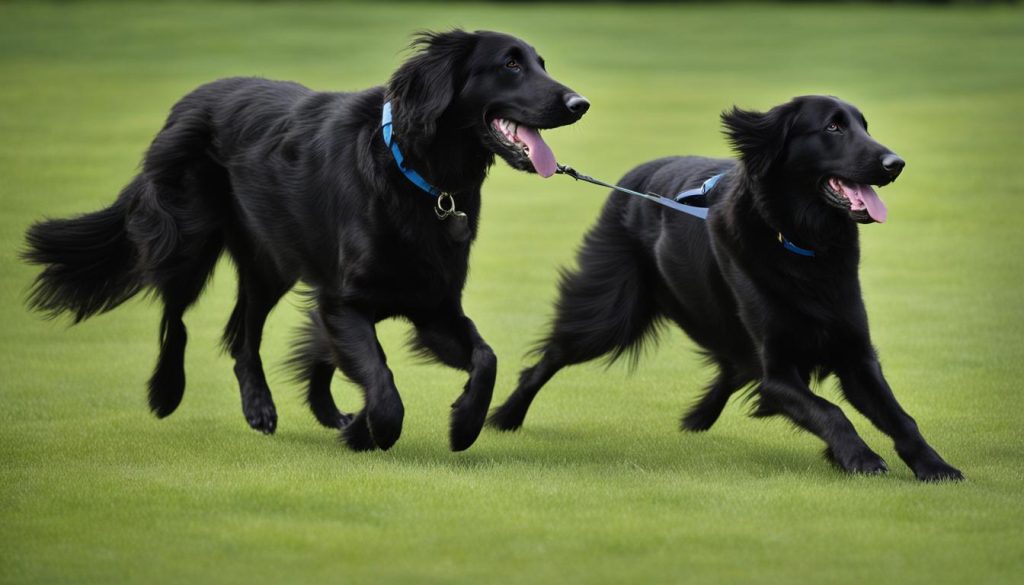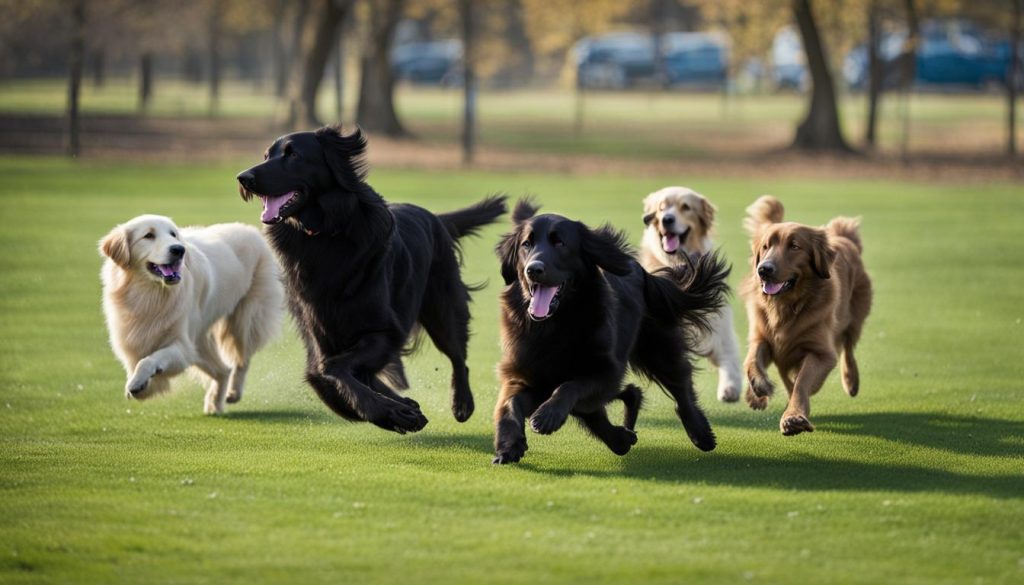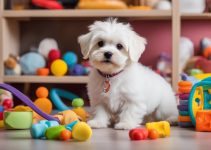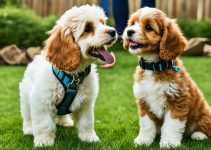When it comes to training your Flat Coated Retriever, it’s important to use effective techniques that focus on positive reinforcement. This means rewarding your dog for desired behaviors rather than punishing them for unwanted behaviors. By using retriever-specific training techniques and commands, you can enhance obedience and behavior in your retriever. In this article, I will share various tips and tricks for Flat Coated Retriever training, including information on obedience training, behavior correction, puppy training, advanced techniques, and more.
Flat Coated Retriever Training
- Positive reinforcement training is highly effective for Flat Coated Retrievers, focusing on rewarding desired behaviors.
- Teaching essential commands such as sit, stay, come, down, leave it, and off improves obedience and safety.
- Puppy training should include housebreaking, socialization, and crate training to establish good behaviors from a young age.
- For advanced training, consider professional retriever training to enhance obedience, retrieving skills, and competition techniques.
- Behavior problems in Flat Coated Retrievers can be corrected through positive reinforcement training and addressing underlying causes.
Why Positive Reinforcement Training is Effective for Flat Coated Retrievers
Positive reinforcement training is a highly effective method for training Flat Coated Retrievers. This approach focuses on rewarding desired behaviors, such as sitting or coming when called, with treats, toys, praise, or petting. By using positive reinforcement, you can create a strong bond with your retriever and motivate them to repeat behaviors that you want to reinforce.
This training method is particularly beneficial for puppies, as it helps them learn and understand commands at a young age. Positive reinforcement training encourages cooperation and obedience in Flat Coated Retrievers without the need for force or punishment.
With positive reinforcement training, you can make the training sessions enjoyable for your retriever, which enhances their willingness to learn and perform commands. This method fosters a positive and trusting relationship between you and your retriever, creating a harmonious training environment.
When using positive reinforcement, it’s important to be consistent and timely with rewards. This allows your retriever to associate the desired behavior with the reward, reinforcing their understanding of what is expected of them. As you continue to reward and reinforce positive behaviors, your retriever will become more responsive and obedient.
Positive reinforcement training also helps to prevent behavioral issues, as it focuses on addressing unwanted behaviors through redirection and reward rather than punishment. By rewarding and reinforcing desirable behaviors, you can effectively guide your retriever towards appropriate behaviors, minimizing the occurrence of problem behaviors.
Positive reinforcement training is a highly effective and humane method for training Flat Coated Retrievers. It strengthens the bond between you and your retriever, enhances their obedience and cooperation, and fosters a positive training environment. By utilizing positive reinforcement techniques, you can successfully train your retriever and have a well-behaved and happy canine companion.
Essential Commands for Flat Coated Retriever Training
When it comes to Flat Coated Retriever training, there are several essential commands that you should focus on. These commands are crucial for obedience training and ensuring the safety of your retriever and those around them. By consistently practicing and reinforcing these commands, you can establish clear communication and create a well-behaved companion.
Sit
The “sit” command is one of the most basic commands that every retriever should learn. It teaches your dog to sit down on command, which is useful in various situations such as greeting visitors or waiting patiently.
Stay
The “stay” command is essential for teaching your retriever to stay in one place until you give them permission to move. This command is crucial for safety, especially when crossing streets or preventing your dog from running away.
Come
The “come” command is vital for calling your retriever back to you. It is essential for their safety and allows you to maintain control in different environments, whether at home, in public spaces, or off-leash areas.
Down
The “down” command teaches your retriever to lie down on command. It is a useful command for situations where you want your dog to relax or stay low, such as during mealtime or when encountering other dogs or people.
Leave it
The “leave it” command is crucial for preventing your retriever from picking up or interacting with objects they shouldn’t, such as toxic substances or items that pose a choking hazard. Teaching this command can help keep your dog safe and prevent them from engaging in potentially dangerous behavior.
Off
The “off” command is used to teach your retriever to get off furniture, people, or objects when instructed. This command is important for maintaining boundaries and preventing unwanted jumping or climbing behaviors.

By incorporating these essential commands into your Flat Coated Retriever’s training routine, you can ensure their obedience and safety. Remember to use positive reinforcement techniques, such as rewards and praise, to motivate and encourage your retriever to respond to these commands consistently.
Puppy Training Tips for Flat Coated Retrievers
Training your Flat Coated Retriever puppy is crucial for their development and overall behavior. To ensure a successful training journey, it is important to establish a consistent routine and focus on key areas such as housebreaking, socialization, and crate training.
When it comes to housebreaking, patience is key. Take your puppy outside frequently, especially after meals or naps, and praise them when they eliminate in the designated area. Using a consistent verbal cue, such as “go potty,” will help them understand what is expected of them.
Proper socialization is essential to ensure your retriever puppy grows up to be friendly and well-adjusted. Introduce them to various people, animals, and environments in a positive and controlled manner. This will help them feel more comfortable and confident in different situations throughout their life.
Crate training can also be beneficial for both you and your puppy. A crate provides a safe and secure space for them and helps with housebreaking and preventing destructive behavior. Make sure the crate is comfortable and enticing by adding bedding and toys. Gradually increase the amount of time your puppy spends in the crate, starting with short intervals and gradually working your way up.
Creating a puppy training schedule is an effective way to establish consistency and structure. Plan regular training sessions throughout the day to teach basic commands and reinforce desired behaviors. Remember to use positive reinforcement techniques such as treats, praise, or playtime to reward your puppy’s good behavior.
- Set a consistent routine for housebreaking, taking your puppy outside frequently and praising them when they eliminate in the designated area.
- Ensure proper socialization by introducing your puppy to different people, animals, and environments in a positive and controlled manner.
- Use crate training to provide a safe and secure space for your puppy, aiding in housebreaking and preventing destructive behavior.
- Create a puppy training schedule to establish consistency and structure, incorporating regular training sessions throughout the day.
- Remember to use positive reinforcement techniques to reward your puppy’s good behavior and motivate them to continue learning.
By following these puppy training tips for Flat Coated Retrievers, you can lay a solid foundation for their training journey and ensure they develop into well-behaved and obedient companions.
Advanced Training Techniques for Flat Coated Retrievers
For Flat Coated Retrievers who have mastered basic obedience, it’s time to take their skills to the next level with advanced training techniques. Whether you’re interested in competition obedience, improving retrieving skills, or training for hunting purposes, there are professional retriever training programs available to help you achieve your goals.
Professional Flat Coated Retriever training goes beyond basic commands and focuses on honing your retriever’s skills and abilities. With advanced obedience commands, your retriever can become even more responsive and dependable. These commands include advanced variations of sit, stay, come, and down, as well as more complex commands like heel, place, and stand. By consistently practicing and reinforcing these commands, your retriever will develop the precision and reliability needed for advanced training and competitions.
Flat Coated Retriever training for specific activities, such as hunting or competition obedience, requires specialized techniques. Hunting training focuses on teaching your retriever to efficiently locate and retrieve game, follow hand signals, and work in various environments. On the other hand, competition obedience training involves perfecting precise and synchronized performances, where your retriever showcases their retrieving skills, obedience, and overall capabilities.
If you’re interested in pursuing advanced Flat Coated Retriever training for your furry friend, it’s essential to work with a professional trainer who specializes in retriever training. A professional trainer can assess your retriever’s abilities, tailor a training program to their specific needs and goals, and provide guidance and support throughout the training process.
Advanced retriever training is a challenging but rewarding endeavor that can bring out the full potential of your Flat Coated Retriever. It not only enhances their retrieving skills and obedience but also strengthens the bond between you and your furry companion.
With advanced training techniques and the guidance of a professional trainer, your Flat Coated Retriever can excel in competitions, hunting expeditions, or simply showcase their impressive skills. Take your retriever’s training to the next level and unlock their full potential through advanced retriever training.
Correcting Behavior Problems in Flat Coated Retrievers
Like any dog, Flat Coated Retrievers may exhibit behavior problems that require training and behavior correction. Common issues include aggression, separation anxiety, and destructive behavior. To address these problems, it is important to use positive reinforcement techniques and identify the underlying causes of the behaviors.
Positive reinforcement training involves rewarding desired behaviors to encourage their repetition. This approach avoids punishment and focuses on reinforcing good behavior instead. By using positive reinforcement, such as treats, praise, and play, you can effectively correct and modify your retriever’s behavior.
For aggression issues, it is essential to seek professional guidance. A professional dog trainer or behaviorist can assess the situation and create a tailored behavior modification plan. They will help you identify triggers, implement strategies to address aggression, and ensure everyone’s safety.
To prevent and address separation anxiety, create a routine that gradually desensitizes your retriever to your departures. Provide comforting toys or treats for them to focus on and consider crate training as a safe space. Gradually increase the time you spend away from your retriever, rewarding calm behaviors, and building their confidence.
Destructive behavior can often be a symptom of boredom or excess energy. Engaging your retriever in regular exercise and mental stimulation can help alleviate this problem. Puzzle toys, interactive games, and obedience training sessions can provide a healthy outlet for their energy and prevent destructive behaviors.
Remember, addressing behavior problems requires patience and consistency. It may take time to see improvements, but with the right Flat Coated Retriever training approach and guidance, you can help your Flat Coated Retriever overcome these challenges and lead a happy, well-behaved life.
The Importance of Socialization for Flat Coated Retrievers
Socialization plays a crucial role in Flat Coated Retriever training. It is essential to socialize your retriever with strangers and other animals to develop good manners and prevent behavior problems. By exposing your retriever to a variety of people, animals, and environments from a young age, you ensure they grow up to be well-rounded and well-behaved dogs.
During the socialization process, it is important to incorporate positive reinforcement techniques and rewards to make the experience enjoyable for your retriever. This not only strengthens the bond between you and your pet but also reinforces proper behavior in social settings.
Introducing your retriever to strangers helps them become comfortable with new people and reduces the chances of fear or aggression towards unfamiliar individuals. Similarly, socializing with other animals teaches your retriever to interact appropriately with different species, promoting harmony in multi-pet households or public spaces.
Remember, socialization should start early and continue throughout your retriever’s life. Gradually expose them to various situations, such as walks in the park, visits to friends’ houses, or outings to pet-friendly stores. Allow your retriever to interact with different breeds and sizes of dogs to ensure they can effectively navigate social interactions in the future.

- Take your retriever to puppy training classes or obedience classes where they can meet other dogs and receive guidance from professional trainers.
- Arrange playdates with well-behaved dogs to encourage positive social interactions and provide opportunities for your retriever to practice proper manners.
- Expose your retriever to various human activities, such as family gatherings or outdoor events, to help them become comfortable in different social environments.
- Introduce your retriever to a variety of sounds, sights, and objects to ensure they are not easily startled or anxious in new situations.
By prioritizing socialization in your Flat Coated Retriever training journey, you lay the foundation for a well-behaved and confident companion. Remember to be patient, consistent, and positive throughout the process to maximize your retriever’s socialization success.
Conclusion
Effective Flat Coated Retriever training requires dedication, patience, and the use of positive reinforcement techniques. By consistently implementing these methods, focusing on obedience, and addressing behavior issues, you can achieve remarkable results in enhancing your retriever’s obedience and overall behavior.
Whether you are starting with a puppy or working with an adult retriever, positive reinforcement and consistency are the keys to successful training outcomes. Remember to tailor the training methods to your retriever’s individual needs and abilities, as every dog is unique. And if you encounter challenges along the way, don’t hesitate to seek professional training assistance.
With your commitment and the right approach, you can train your Flat Coated Retriever to be a well-behaved, happy, and obedient companion. By establishing a strong bond, using positive reinforcement, and addressing any behavior issues, you can provide your retriever with the training they need to thrive and enjoy a fulfilling life as a beloved member of your family.
FAQ
What is positive reinforcement training and why is it effective for Flat Coated Retrievers?
Positive reinforcement training focuses on rewarding desired behaviors with treats, toys, praise, or petting. This training method is highly effective for Flat Coated Retrievers because it creates a strong bond, motivates them to repeat desired behaviors, and encourages cooperation and obedience without the need for force or punishment.
What are the essential commands for Flat Coated Retriever training?
The essential commands for Flat Coated Retriever training include sit, stay, come, down, leave it, and off. Teaching your retriever these basic commands improves their obedience, ensures their safety, and establishes clear communication.
What are some tips for training Flat Coated Retriever puppies?
To train your Flat Coated Retriever puppy, establish a consistent training routine, focus on housebreaking, socialization, and crate training, set a puppy training schedule, provide positive reinforcement, and be patient and consistent.
What are some advanced training techniques for Flat Coated Retrievers?
Advanced training techniques for Flat Coated Retrievers can include advanced obedience commands, retrieving skills, and specialized training for activities such as hunting or competition obedience. Working with a professional trainer can help develop a customized training program tailored to your retriever’s abilities and goals.
How can behavior problems in Flat Coated Retrievers be corrected?
Behavior problems in Flat Coated Retrievers can be corrected through positive reinforcement techniques and addressing the underlying causes of the behavior. Working with a professional dog trainer or behaviorist may be beneficial for more serious behavior problems.
Why is socialization important for Flat Coated Retrievers?
Socialization is crucial for Flat Coated Retrievers to develop good manners, prevent behavior problems, and become well-rounded dogs. Properly socializing them with strangers and other animals from a young age helps ensure their behavior is appropriate in different situations.






